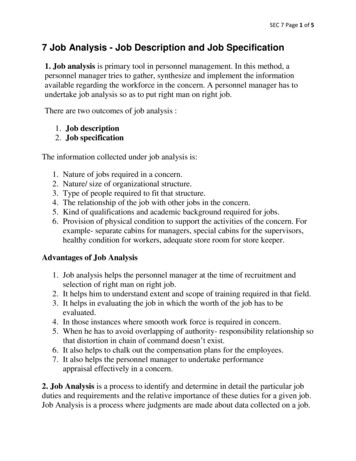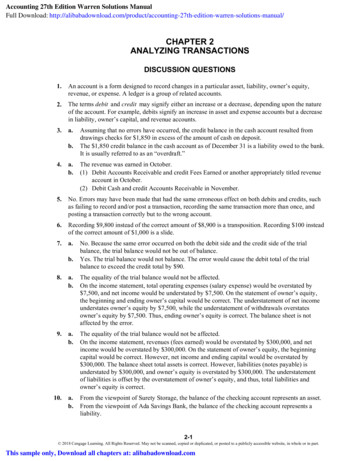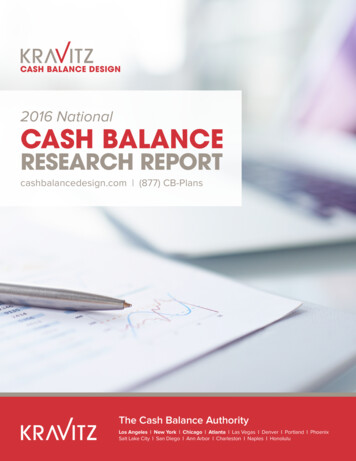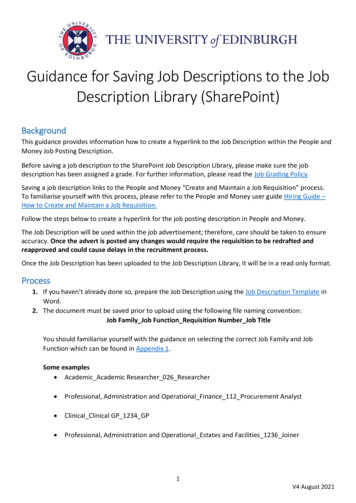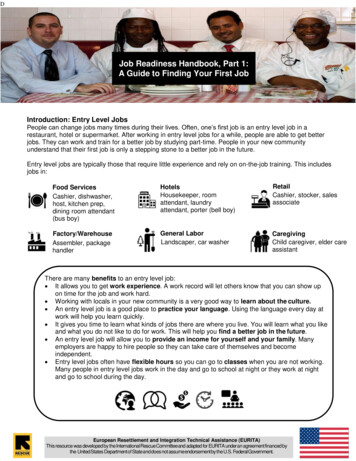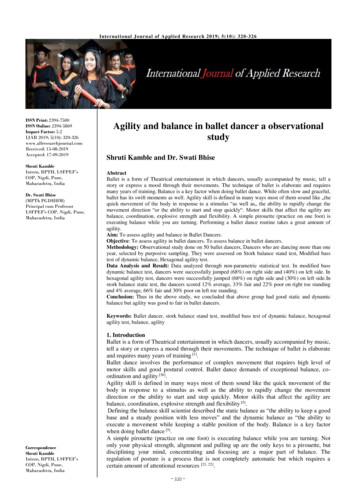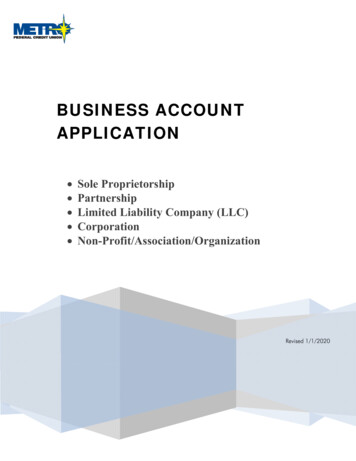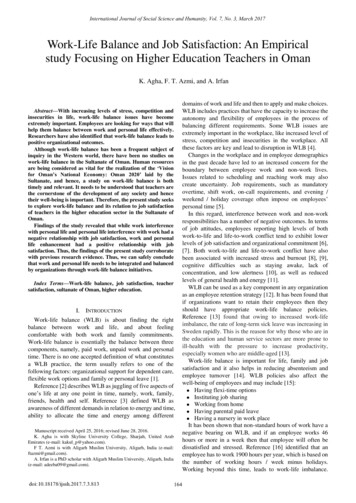
Transcription
International Journal of Social Science and Humanity, Vol. 7, No. 3, March 2017Work-Life Balance and Job Satisfaction: An Empiricalstudy Focusing on Higher Education Teachers in OmanK. Agha, F. T. Azmi, and A. Irfan Abstract—With increasing levels of stress, competition andinsecurities in life, work-life balance issues have becomeextremely important. Employees are looking for ways that willhelp them balance between work and personal life effectively.Researchers have also identified that work-life balance leads topositive organizational outcomes.Although work-life balance has been a frequent subject ofinquiry in the Western world, there have been no studies onwork-life balance in the Sultanate of Oman. Human resourcesare being considered as vital for the realization of the ‘Visionfor Oman’s National Economy: Oman 2020’ laid by theSultanate, and hence, a study on work-life balance is bothtimely and relevant. It needs to be understood that teachers arethe cornerstone of the development of any society and hencetheir well-being is important. Therefore, the present study seeksto explore work-life balance and its relation to job satisfactionof teachers in the higher education sector in the Sultanate ofOman.Findings of the study revealed that while work interferencewith personal life and personal life interference with work had anegative relationship with job satisfaction, work and personallife enhancement had a positive relationship with jobsatisfaction. Thus, the findings of the present study corroboratewith previous research evidence. Thus, we can safely concludethat work and personal life needs to be integrated and balancedby organizations through work-life balance initiatives.Index Terms—Work-life balance, job satisfaction, teachersatisfaction, sultanate of Oman, higher education.I.INTRODUCTIONWork-life balance (WLB) is about finding the rightbalance between work and life, and about feelingcomfortable with both work and family commitments.Work-life balance is essentially the balance between threecomponents, namely, paid work, unpaid work and personaltime. There is no one accepted definition of what constitutesa WLB practice, the term usually refers to one of thefollowing factors: organizational support for dependent care,flexible work options and family or personal leave [1].Reference [2] describes WLB as juggling of five aspects ofone’s life at any one point in time, namely, work, family,friends, health and self. Reference [3] defined WLB asawareness of different demands in relation to energy and time,ability to allocate the time and energy among different Manuscript received April 25, 2016; revised June 28, 2016.K. Agha is with Skyline University College, Sharjah, United ArabEmirates (e-mail: kakul p@yahoo.com).F T. Azmi is with Aligarh Muslim University, Aligarh, India (e-mail:ftazmi@gmail.com).A. Irfan is a PhD scholar with Aligarh Muslim University, Aligarh, India(e-mail: adeeba09@gmail.com).doi: 10.18178/ijssh.2017.7.3.813164domains of work and life and then to apply and make choices.WLB includes practices that have the capacity to increase theautonomy and flexibility of employees in the process ofbalancing different requirements. Some WLB issues areextremely important in the workplace, like increased level ofstress, competition and insecurities in the workplace. Allthese factors are key and lead to disruption in WLB [4].Changes in the workplace and in employee demographicsin the past decade have led to an increased concern for theboundary between employee work and non-work lives.Issues related to scheduling and reaching work may alsocreate uncertainty. Job requirements, such as mandatoryovertime, shift work, on-call requirements, and evening /weekend / holiday coverage often impose on employees’personal time [5].In this regard, interference between work and non-workresponsibilities has a number of negative outcomes. In termsof job attitudes, employees reporting high levels of bothwork-to-life and life-to-work conflict tend to exhibit lowerlevels of job satisfaction and organizational commitment [6],[7]. Both work-to-life and life-to-work conflict have alsobeen associated with increased stress and burnout [8], [9],cognitive difficulties such as staying awake, lack ofconcentration, and low alertness [10], as well as reducedlevels of general health and energy [11].WLB can be used as a key component in any organizationas an employee retention strategy [12]. It has been found thatif organizations want to retain their employees then theyshould have appropriate work-life balance policies.Reference [13] found that owing to increased work-lifeimbalance, the rate of long-term sick leave was increasing inSweden rapidly. This is the reason for why those who are inthe education and human service sectors are more prone toill-health with the pressure to increase productivity,especially women who are middle-aged [13].Work-life balance is important for life, family and jobsatisfaction and it also helps in reducing absenteeism andemployee turnover [14]. WLB policies also affect thewell-being of employees and may include [15]: Having flexi-time options Instituting job sharing Working from home Having parental paid leave Having a nursery in work placeIt has been shown that non-standard hours of work have anegative bearing on WLB, and if an employee works 46hours or more in a week then that employee will often bedissatisfied and stressed. Reference [16] identified that anemployee has to work 1900 hours per year, which is based onthe number of working hours / week minus holidays.Working beyond this time, leads to work-life imbalance.
International Journal of Social Science and Humanity, Vol. 7, No. 3, March 2017Compressed working weeks or compressed hours of workcan help an employee work fewer days to achieve theirtargets and then they can manage their family responsibilitiesduring the remaining days [16]. Flexi- time also has apositive impact on productivity [17]. In the same way,flexi-time enables women employees achieve greater balancebetween family and work roles [18].The nature of the job, workplace environment,employee-friendly policies and organizational culture have apositive impact on WLB [19]. All employee-friendly policiesthat are beneficial to employees, increase job satisfaction andorganizational commitment. In addition to this, [20]examined that family-responsive policies, flexible-workschedule and dependent care, as part of WLB policies, havehad a positive impact on turnover intentions andorganizational commitment. As a result, adopting a strategicWLB framework at the firm level, is pertinent [21].Reference [22] suggested that WLB practices depend onattracting better applicants and reducing work-life conflict,hence, it enhances organizational performance. Reference[23] found that WLB policies and practices reap benefits tothe organization that can be measured financially, namely,increased productivity, lower absenteeism, reducedoverheads, improved recruitment and retention.Job satisfaction is how people feel about their job. Itdepends on the extent to which people are satisfied ordissatisfied with their job. Reference [24] identified that jobsatisfaction is an important predictor of overall well-beingand employee intentions to quit. As a result, there is arelationship between job satisfaction and employee retention[25]. Reference [26] too concluded that job satisfaction is apositive outcome of WLB. Reference [27] suggested thatwhen an employee perceives that his/her employer issupportive and is helpful in integrating family and workrelated issues, it results in a higher level of job satisfactionand organization commitment. Reference [28] determinedthat there is impact of work obligations on personal life andthat there is a link or relationship between the WLB and jobsatisfaction. Reference [29] found that if there is fairness inpolicies, then the workers are likely to be more satisfied.II.strain is viewed as a serious concern for faculty, particularly,newer and female faculty. It examined differences in levels ofoccupational stress and personal strain experienced by newand experienced female and male faculty. Results on thenegative impact of role overload and avoiding coping onmeasures of personal strain are consistent with the literatureand suggest the need for promoting different copingstrategies in the academic workplace as well as working withfaculty to help them prioritize and balance their dailyworkloads [32].Reference [33] found that retention of female faculty is animportant issue for higher education institutions aiming forexcellence and diversity. The first step in understandingretention is to examine what contributes to career satisfactionfor academic women. Using the reference [34] model forconceptualizing faculty job satisfaction, the study identifiesdomains of environmental condition, departmental climateand demographics play a role in female faculty's overallcareer satisfaction.The Sultanate of Oman has a long-standing policy ofhuman resource development through education and training,although the Omani higher education system is relativelyyoung and is in its juvenile stages of development. Thegovernment is taking steady strides to enhance the quality,pervasiveness and robustness of the education system in theSultanate. Although, a large number of studies are availableon the growth and development of the higher educationsystem, minimal research has been found on the humanresource management issues related to teachers.Reference [35] studied job satisfaction and organizationalcitizenship behavior both from private as well public sectorsin Oman. Another study [36] concluded that certaindemographic variables such as age, tenure have bearing onjob satisfaction and organization commitment. Reference [37]conducted a study in Oman to test job satisfaction amongschool teachers of Oman, and in the school, turnoverproblems were checked.However, the researchers did not find any studies onwork-life balance in Oman that focused specifically on thehigher education sector. They have identified that highereducation and training and development are the key tosuccess. Human resource development is at the heart of themajor strategies considered critical to the realization of the‘Vision for Oman’s National Economy: Oman 2020’, whichis the vision laid by the Sultanate [38].CONCEPT OF WORK-LIFE BALANCEReference [30] explores the interface between work andfamily at different types of institutions from the perspectiveof women faculty who are on the tenure track and who aremothers of young children. Such a perspective providesinsight into institutional variation on academic life in general,and for new faculty as mothers, in particular. A macro-viewof the findings points to two major concerns, namely, time(and lack thereof) and its impact on the ideal worker normsthat shape what it means to be a good mother and goodprofessor at different institutional types, as well as, the ideaof ‘choice’ as an illusion.Reference [31] found that making use of at least onework-family policy helped academic mothers increase theirproductivity (without increasing their hours of work). But italso appears that this help is not treated as a needs-basedentitlement.For Reference [32], the presence of work-related stress andIII.STUDY OBJECTIVESIn light of the research gaps, the following objectives wereidentified To measure work-life balance, teaching and jobsatisfaction of teachers in the higher educationinstitutions in the Sultanate of Oman To explore the relationship between work-life balance,teaching satisfaction and job satisfactionIV.RESEARCH CONSTRUCTSReference [39] explained why WLB is significant and howthe stressful events of life have an impact on work-life165
International Journal of Social Science and Humanity, Vol. 7, No. 3, March 2017balance. Reference [40] developed an instrument in the formof a WLB checklist. Reference [41] presented significantinsights into the troubles of combining family aspirationswith salaried work in relation to policy relevant agendas withthe help of a social survey.Reference [42] investigate the role of time diaries in thestudy of WLB; which consider three sets of WLB measures:1) proportion of free time, 2) overlap of work and life, and 3)time spent with other people. Reference [43] reviewedmethodological choices (sampling frames, measures usedand constructs investigated) in 245 empirical work-lifebalance papers published between 1987 and 2006. Resultsshowed that WLB studies require setting-up better reliabilitybetween the conceptualization of constructs and theoperationalization of measures.Reference [44] defined work-home interaction bydeveloping four types of work-home interaction. Thequestionnaire measured four different types of work-homeinteraction, and this four-dimensional configuration waslargely invariant across the five samples as well as acrossrelevant subgroups. Reference [45] developed a theoreticalframework that explained how life complexity and dynamismaffect work-life balance which were taken as independentvariable and WLB as dependent variable. Reference [46]carried out the psychometric assessment of an instrumentdesigned to measure work-life balance. The purpose of studywas to evaluate a 15 item scale for assessing the construct ofWLB with the intention to find the balance betweenlife-to-work and work-to-life. For the present study, WLBconstructs have been adopted from the study of [46].Job Satisfaction (JS) scale consists of items like nature of thejob with respect to teaching and opportunities for doingresearch. The Teaching Satisfaction (TS) scale was adaptedfrom [55].C. Moderating Variables: Demographic ProfileSeveral studies in the area [49], [50] have taken gender asmoderating variable, whereas in some studies, age isconsidered as a moderating variable. In several studies [51],marital status was taken as moderating variable. Income hasalso been taken as a moderating variable in some studies [52],[53].The moderating variables considered for the present studywere gender, nationality, educational status, number of yearsof experience, and current grade in organization on the linesof [27], [34], [46]. WLB and JS were measured using a5-point Likert scale anchored with the end points 1 stronglydisagree to 5 strongly agree. Reference [55] used a similarscale. In case of measuring JS, a 5-point Likert scaleanchored with the end points 1 extremely dissatisfied to5 extremely satisfied was used. These descriptors werechosen to balance or neutralize any tendency to over-reportdifficult or unacceptable behaviours and conditions faced bythe respondents at their workplace [56].Reference [57] pointed out that researchers should designquestionnaire items that capture the specific substantivefocus of the component being assessed. Hence, efforts weremade to keep the items as simple, specific and objective aspossible. Reference [58] found that a long questionnairetends to have a lower response rate. For this study, thequestionnaire length was deliberately kept at two sides of asingle page.As the study was conducted in the Sultanate of Omanwhere the native language is Arabic, the completequestionnaire, including instructions, scale and questionswere translated into Arabic. To avoid discrepancies intranslation, back translation method suggested by [59] wasused.A. Independent Variable: Dimensions of WLBWork Interference with Personal Life (WIPL): Accordingto [46], WIPL includes those work-related factors that impactthe personal life of individuals. This construct tries tomeasure the impact of work on the personal life ofindividuals. It consist of items like: My personal life suffersbecause of work, I put personal life on hold for work.Personal Life Interference with Work (PLIW): Reference[46] explains PLIW as the impact of or the interference ofpersonal life on work. This construct aims at measuring thereverse phenomenon, namely, the impact of personal life onthe work of individuals. There were four items to measurethis construct like: I am too tired to be effective at work.Work Personal Life Enhancement (WPLE): WPLEexplains how both work and personal life enhance andsupport each other. The items listed in this construct help tounderstand the support and enhancement provided by workon personal life and vice versa. This was measured using fouritems, for example, my job gives me energy to pursuepersonal activities.1) Pilot testingA pilot study was conducted to determine if responseswere normally-distributed or skewed. The questionnaire wasadministered to teaching staff of a higher educationinstitution in Oman. In all, 63 responses were generated atthis stage. Based on the input, minor modifications wereincorporated in the questionnaire wording, thus enhancing itscontent validity. The responses generated during the pilotwere also tested using SPSS version 17.0, and it was foundthat the responses were normally-distributed, thereby,suggesting that the instrument was appropriate for furtherdata collection.2) Sampling techniqueIn order to ensure a rigorous research design, care wasexercised that a sound sampling procedure was followed.Sampling units, sampling elements and sampling frameswere carefully selected. Both private and public highereducation institutions in Oman were included in the study.The sampling frame was derived from the database of theDirectorate General of Private Universities and Colleges ofthe Ministry of Higher Education (MoHE), Sultanate ofB. Dependent Variable: Job Satisfaction (JS)Job satisfaction is seen to be related to WLB. Further, it isalso dependent on Teaching Satisfaction (TS) as discussedinitially. The Job Satisfaction Scale used in the present studywas adapted from the study of [47]. The elements chosen by[47] to develop the job satisfaction scale were almostidentical to those of the popular job descriptive index, whichhas been found to produce highly-reliable results [48]. The166
International Journal of Social Science and Humanity, Vol. 7, No. 3, March 2017Oman. For the study, the respondents were teachers in bothpublic and private higher education institutions in Oman. Atotal of 1769 teachers from private institutions werecontacted, and out of the total of 2717 employees in thegovernment institutions, 1500 could be approached owing toa refusal of certain institutions to participate in the survey.Data was collected from the sample organizations primarilythrough postal mails, e-mails (2000) and personal visits(1269). The mail methodology has also been used by otherresearchers in this area of study [60].Reference [61] suggested that an adequate sample size forCFA analysis or Structural Equation Modeling (SEM) is100-150 participants. Further [62] suggests that the ratio ofsample size to free parameters should ideally be 5:1 though aratio of 10:1 may be appropriate. Since the final number ofresponses was 625, the ratio was more than the recommendedratio, thus signaling that the sample size was appropriate toproceed with SEM.V.H06: WPLE has a positive relationship with JS.4) Investigating the relationship between teachingsatisfaction (TS) and job satisfaction (JS)H07: Teaching satisfaction (TS) has a positive relationshipwith JS.B. AnalysisDescriptive statistics of the responses were generatedthrough SPSS 17.0. After initial estimation of response rateConfirmatory Factor Analysis (CFA) was carried out usingStructural Equation Modeling (SEM) capabilities of LISREL8.50. Indicator and scale reliability were assessed.Convergent and discriminant validity was ascertained. Therelationship between dependent and independent variableswas assessed using Maximum Likelihood Estimation (MLE)method in LISREL.C. Response Rate and Item Completion RateOut of the 3269 respondents who were contacted throughe-mails, postal mails and personal contact, responses werereceived from 625 respondents. The completed surveyinstruments totaled around 19.11 per cent response rate. Theitem completion is another important measure ofeffectiveness of the survey [66], [67]. Out of the 625responses initially received, four questionnaires had missingdata, hence the item completion rate was 99.0 per cent,suggesting an exceptionally high survey effectiveness.CONCEPTUAL MODEL OF RESEARCHSeveral scholars [6], [7], [44], [46], [63], [64], [65] haveshown that WLB affects organization commitment,employee loyalty and job satisfaction. Based on the findings,a research model was conceptualized. Exhibit 1 illustrates theconceptual research model.D. Assessing Scale UnidimensionalityScale unidimensionality was checked using ConfirmatoryFactor Analysis (CFA). For many researchers, CFA is a morerigorous test of assessing the measurement model when usingSEM [68]. Thus, it was decided to perform CFA as a test ofscale unidimensionality, reliability and validity.A goodness of fit index (GFI) of 0.90 or close suggests thatevidence for unidimensionality exists. Additionally,Adjusted Goodness of Fit Index (AGFI) ‘greater than 0.9’isacceptable [69]. Reference [70] recommend that Normed FitIndex (NFI), Non-Normed Fit Index (NNFI) and theComparative Fit Index (CFI) should be studied to estimatethe accuracy of the different models. Another aspect ofevaluating the measurement model is to examine thedirection (positive), magnitude (standard loadings of 0.70 oreven 0.50 is acceptable) and statistical significance (t 1.96)of the parameter estimates between indicators and latentvariables [70]. When the measurement model was estimatedusing CFA the scales viz. WIPL, PLIW, WPLE and TS, thefit indices were found to be more than the minimum acceptedvalues. A summary of items in each scale with their GFIvalues are given in Table I along with loading value range.Exhibit 1. Conceptual research model.A. Research HypothesesFour sets of research hypotheses were considered in lightof the research model:1) Investigating the relationship between workinterference with personal life (WIPL), teachingsatisfaction (TS) and job satisfaction (JS)H01: WIPL has a negative relationship with TS.H02: WIPL has a negative relationship with JS.2) Investigating the relationship between personal lifeinterference with work (PLIW), teaching satisfaction(TS) and job satisfaction (JS)H03: PLIW has a negative relationship with TL.H04: PLIW has a negative relationship with JS.TABLE I: GFI VALUES FOR ALL SCALESNumber of Items withLoading ValueScaleGFI valuesRange0.64-0.847 Items (GFI 0.90)WIPLPLIW4 Items (GFI 0.95)0.70-0.903) Investigating the relationship between work Personallife enhancement (WPLE), teaching satisfaction (TS)and job satisfaction (JS)H05: WPLE has a positive relationship with TS.WPLE4 Items (GFI 0.93)0.60-0.77TS5 Items (GFI 0.92)0.59-0.86JS8 Items (GFI 0.90)0.46-0.75167
International Journal of Social Science and Humanity, Vol. 7, No. 3, March 2017E. Assessment of ReliabilityAfter establishing the unidimensionality of the scales, theresearchers tested the statistical reliability of the scales beforeproceeding with the validation analysis. Two types ofreliability estimates were calculated, namely, (1) Indicatorreliability and (2) Scale reliability. The indicator reliability ofthe five scales, namely, WIPL, PLIW, WPLE, TS and JS,used in this study were high or close to the desired values.Scale reliability was measured using Cronbach’s alpha extracted measures as suggested by [70]. All valueswere found to be acceptable. Reliability values are shown inTable II.ScaleWIPLPLIWWPLETSJSTABLE II: RELIABILITY 90.4-0.60.80.80.4-0.70.80.80.3-0.60.80.8of convergent validity that attempts to assure that there is atleast moderate correlation among the indicators. For thisstudy, all the scales had loadings of more than 0.5 whichindicates convergent validity. The convergent validity of thefive scales was also checked through the Bentler-BonettNormed Fit Index (NFI). A value of 0.90 and abovedemonstrates strong convergent validity [72]. The NFI andNNFI coefficient for all the constructs was greater than 0.90,indicating high convergent validity. The values are depictedin Table III.TABLE III: NFI AND NNFI VALUES OF 60.50.50.4For the study, the difference between the alpha value foreach of the five constructs and the average correlation of eachconstruct with other constructs was fairly large. Thisprovides evidence of discriminant validity for the five scales.Table IV provides evidence for discriminant validity for allthe five scales used for the present study.F. Convergent and Discriminant ValidityReference [71] explained that internal consistency is a typeTABLE IV: DISCRIMINANT VALIDITY (DV) OF SCALESExistence ofDVCorrelationsAverage ofCorrelationsAlphaValues0.450.40.9 0.410.430.40.9 0.290.220.20.8 1.000.680.50.8 -1.000.50.8 .12--1.00------WPLETSJSThe GFI values of all the study scales presented in Table Iare significant and fall in line with the recommended values.The high values are an evidence of both convergent anddiscriminant validity since strong GFI is characteristic ofconvergence within a construct as well indicative of oneconstruct being different from others.VI.were found to be significantly correlated with the studyvariables. All correlation values indicated a weak correlation.Thus, it was concluded that the hypothesized moderatingvariables did not have a significant influence on therelationships and, hence, they were not incorporated in thefinal structural model.STRUCTURAL MODEL ASSESSMENTFor the present study the structural model fit was assessedto examine the hypothesized relationships between WIPL,PLIW and WPLE dimensions (independent variables) andTS and JS (dependent variable). Five moderating variableswere considered, namely, gender, nationality, educationalstatus, years of experience and current grade in organization.To control the effect of moderating variables in the structuralmodel analysis, all the moderating variables were firstincluded in a correlation matrix along with the other studyvariables ( WIPL, PLIW, WPLE, TS and JS), in line with amethod suggested by [54]. None of the moderating variablesExhibit 2. Structural model.168
International Journal of Social Science and Humanity, Vol. 7, No. 3, March 2017The standardized path coefficients of the structural modelas estimated by LISREL 8.50 were used to assess themagnitude and direction of relationships and test the studyhypotheses. The structurally-assessed model is depicted inExhibit 2.WIPL had a negative relationship with teachingsatisfaction as indicated by the structural path coefficient(β -0.19).WIPL had a negative relationship with job satisfaction asindicated by the structural path coefficient (β -0.29).PLIW had a negative relationship with teachingsatisfaction as indicated by the structural path coefficient(β -0.34).PLIW also had a negative relationship with job satisfactionas indicated by the structural path coefficient (β -0.05).WPLE had a positive relationship with teachingsatisfaction as indicated by the structural path coefficient(β 0.29).As hypothesized, WPLE had a positive relationship withjob satisfaction too as indicated by the structural pathcoefficient (β 0.01). Teaching satisfaction and jobsatisfaction have a positive relationship as is evident from thestructural path coefficient (β 0.53). Thus, it can be seen thatall the study hypotheses were accepted. The fit indices aregiven in Table V. All values are acceptable indicating a highmodel fit.the path-breaking research by [75] who identify the‘Cognitive Intrusion of Work’, which is interference ofwork-related thoughts and worrying aspects during non-worksettings and non-work timings. Reference [75] also reportsthat cognitive intrusion of work reduces job satisfaction. Thiswas hypothesized in the [46] scale too used by theresearchers.Thus, we can safely conclude that work and personal lifeneed to be integrated in a smooth manner and should not beleft to impact on each other in a negative way. This balance orimbalance is likely to affect the overall performance of theteachers as well as the overall performance of theorganization [76].In organizations where employees perceive that work-lifebalance policies like flexibility, family-friendly benefits,work-life programmes and initiatives exist, it shows thatemployers are interested in the benefit and well-being of theiremployees. As a consequence, employees’ job satisfaction isenhanced leading to heightened levels of commitment andloyalty to the organizational objectives and mission [27],[77]-[81].An important contribution of this study is that it adds to thebase of information and knowledge in this domain, byexploring the relatively-uncharted context of Oman. It is alsonoteworthy that it is a pioneering work in Oman, and hassignificant implications for researchers as well as policymakers in higher education institutions in the Sultanate ofOman. This study validates the relationship betweenwork-life balance, teaching satisfaction and job satisfactionin the context of higher education institutions in the Sultanateof Oman. It can be replicated in other contexts and culturalsettings by future researchers.ACKNOWLEDGMENTTABLE V: CRITERION VALIDITY SEM FIT INDICESFIT INDICATORSValueGoodness of Fit Index (GFI)0.8Adjusted Goodness of Fit Index (AGFI)0.8Normed Fit Index (NFI)0.9Non-Normed Fit Index (NNFI)0.9Comparative Fit Index (CFI)0.9Root Mean Square Error of Approximation(RMSEA)0.08The authors acknowledge the respondents and colleagueswho supported us to complete this research.REFERENCES[1]It is interesting to note that criterion-related validity is ameasure of how well scales representing the variousindependent (predictor) variables are related to measures ofdependent variable (criteria) [73].
satisfaction of teachers in the higher education institutions in the Sultanate of Oman To explore the relationship between work-life balance, teaching satisfaction and job satisfaction . IV. R ESEARCH C ONSTRUCTS. Reference [39] explained why WLB is significant and how the stressful events of life have an impact on work-life
